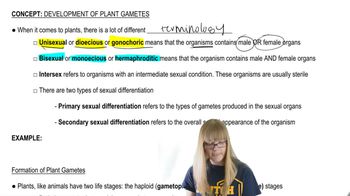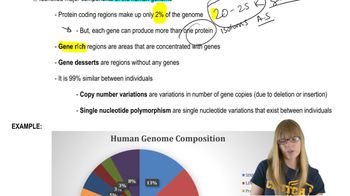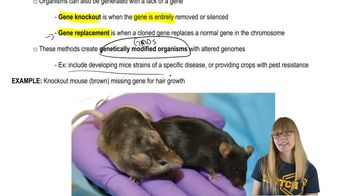Table of contents
- 1. Introduction to Genetics51m
- 2. Mendel's Laws of Inheritance3h 37m
- 3. Extensions to Mendelian Inheritance2h 41m
- 4. Genetic Mapping and Linkage2h 28m
- 5. Genetics of Bacteria and Viruses1h 21m
- 6. Chromosomal Variation1h 48m
- 7. DNA and Chromosome Structure56m
- 8. DNA Replication1h 10m
- 9. Mitosis and Meiosis1h 34m
- 10. Transcription1h 0m
- 11. Translation58m
- 12. Gene Regulation in Prokaryotes1h 19m
- 13. Gene Regulation in Eukaryotes44m
- 14. Genetic Control of Development44m
- 15. Genomes and Genomics1h 50m
- 16. Transposable Elements47m
- 17. Mutation, Repair, and Recombination1h 6m
- 18. Molecular Genetic Tools19m
- 19. Cancer Genetics29m
- 20. Quantitative Genetics1h 26m
- 21. Population Genetics50m
- 22. Evolutionary Genetics29m
15. Genomes and Genomics
Genomics and Human Medicine
Problem 11a
Textbook Question
You have identified a gene encoding the protein involved in the rate-limiting step in vitamin E biosynthesis. How would you create a transgenic plant producing large quantities of vitamin E in its seeds?
 Verified step by step guidance
Verified step by step guidance1
Identify the gene responsible for the rate-limiting step in vitamin E biosynthesis and isolate it using molecular cloning techniques.
Design a plant expression vector that includes the isolated gene, a strong seed-specific promoter to ensure high expression in seeds, and a selectable marker gene for identifying transformed plants.
Introduce the expression vector into the plant cells using a method such as Agrobacterium-mediated transformation or biolistic particle delivery (gene gun).
Select and regenerate transformed plants by growing them on a medium containing the selective agent corresponding to the marker gene, ensuring only transformed cells survive and develop into whole plants.
Screen the transgenic plants for high levels of vitamin E production in their seeds by analyzing the vitamin E content using biochemical assays.
Recommended similar problem, with video answer:
 Verified Solution
Verified SolutionThis video solution was recommended by our tutors as helpful for the problem above
Video duration:
2mPlay a video:
Was this helpful?
Key Concepts
Here are the essential concepts you must grasp in order to answer the question correctly.
Transgenic Plants
Transgenic plants are genetically modified organisms that have had a foreign gene inserted into their genome. This process typically involves the use of techniques such as Agrobacterium-mediated transformation or biolistics. By introducing a gene that enhances a specific trait, such as increased vitamin E production, researchers can create plants with desirable characteristics for agricultural or nutritional purposes.
Recommended video:
Guided course

Plant Gamete Terminology
Gene Expression Regulation
Gene expression regulation refers to the mechanisms that control the timing and amount of gene product produced in a cell. In the context of creating a transgenic plant, it is crucial to ensure that the introduced gene is expressed at the right levels and in the appropriate tissues, such as seeds. This can involve using specific promoters that drive expression in seed tissues or employing regulatory elements that enhance or suppress gene activity.
Recommended video:
Guided course

Penetrance and Expressivity
Vitamin E Biosynthesis Pathway
The vitamin E biosynthesis pathway involves a series of enzymatic reactions that convert precursor molecules into tocopherols, the active forms of vitamin E. Understanding this pathway is essential for identifying the rate-limiting step and the specific gene encoding the corresponding enzyme. By manipulating this pathway through genetic engineering, it is possible to enhance the accumulation of vitamin E in plant seeds, thereby increasing their nutritional value.
Recommended video:
Guided course

Repair Pathways

 6:51m
6:51mWatch next
Master Human Genome Composition with a bite sized video explanation from Kylia Goodner
Start learningRelated Videos
Related Practice



